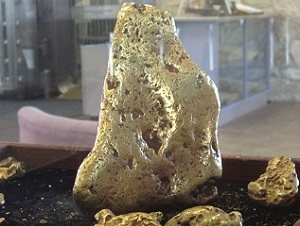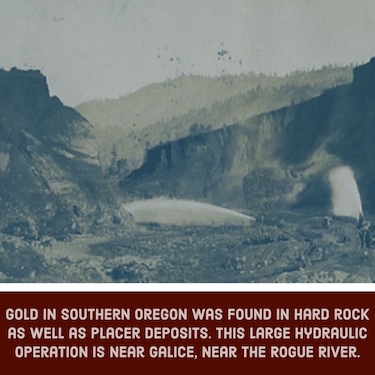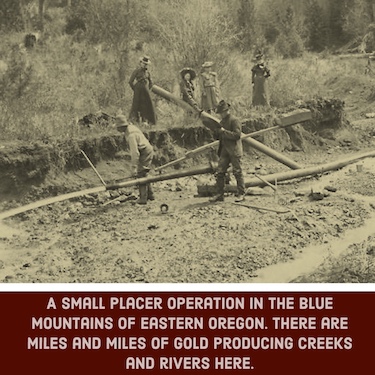
Oregon’s largest gold nugget that still exists today. It weighs over 80 troy ounces. It’s on display at the US Bank in Baker City.
Oregon is a super place for the prospector, for a couple of reasons. One, there’s a lot of gold there, and two, there is a lot of public land to try your hand. The northeastern part of the state and the southwestern part of Oregon just above the California border are the two best regions to prospect.
Southwest Oregon
In southwestern Oregon, rich placer deposits were discovered in 1851 in Josephine Creek and some of the other creeks close by. Not long after that gold was discovered at the Rogue, Applegate, and Illinois Rivers. In a very shot time a tremendous amount of gold was found at Gold Beach and in no time there were thousands of people looking for their fortune in the southwestern part of the state.
Gold in lode and placer form is found all through the Siskiyou Mountains. Check out Jackson, Josephine counties along with the south part of Douglas County, as well as some parts of Coos and Curry Counties. Grants Pass and Medford areas are worth a look as they both produced significant amounts of gold in the past.

Douglas County: check Cow, Myrtle, Last Chance and Quines Creeks, as well as the South Umpqua River and all waters draining into them. There was some hydraulic operations, and both placers and lodes have produced here.
Jackson County: this area would be worth your while as over half million ounces have come out of this area since it was discovered in 1852. You can find gold in all the waters here, but definitely have a try along Palmer, Sterling, Elk and Willow Creeks.
Josephine County: be on the lookout here for old lode mines, placers and hydraulic pits, as plenty of gold came out of this region in the past. Worth checking out are the Illinois River as well as Josephine, Althouse and Galice Creeks.
Curry & Coos Counties: watch for black sand deposits; the beaches offer very fine textured gold. The Sixes River is also likely to produce gold for you.
Eastern Oregon
Almost 2/3 of the gold production came from just a few counties here. There is a gold belt stretching approximately 100 miles long and 50 miles wide, and it covers a good deal of Union, Grant and Baker Counties. The area is littered with old mines, hydraulic and hand placers, and areas that have been torn up by bucket line dredging.
This belt begins at the Snake River by the Idaho border. Traveling from Huntington to the foot of the Wallowa Mountain range, there are several mining districts that are profitable. The Burnt River is located along Highway 84 and most waters that flow into it will have gold. You may only want to try your hand in the lower elevations in the spring when there is still snow runoff, as these are some pretty dry areas.
To the west lie the Blue Mountains, and upstream from Baker the Powder River has been mined since the 1860s. The Sumpter Valley was worked for awhile with bucket dredges, and there are miles of stirred up valley floors.

Since the older dredges discarded larger pieces by design, the tailing piles still contain nuggets that would have been lost to the miners initially. Some other old mining towns that might be worth checking are Greenhorn, Bourne, Granite and Susanville.
The incredible 80.4 ounce Armstrong Nugget was found in the old mining town of Susanville, Grant County in Buck Gulch, the next county west of Baker County in 1913 by George Armstrong and Dick Stewart. If you’re ever in Baker City, the nugget is on display at the bank across the street from the Geiser Grand Hotel, but don’t ask to hold it – they won’t let you!
Following the gold belt west, the John Day River and drainages are definitely worth a look. Placer gold can be found in most of the creeks in this part of the state.
Next: Where to Sell the Gold that you Find

